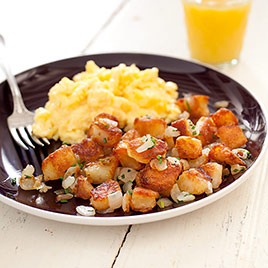
Don’t skip the baking soda in this recipe. It’s critical for home fries with just the right crisp texture.
Ingredients
- 3 1/2pounds russet potatoes, peeled and cut into ¾-inch dice
- 1/2teaspoon baking soda
- 3tablespoons unsalted butter, cut into 12 pieces
- Kosher salt and pepper
- Pinch cayenne pepper
- 3tablespoons vegetable oil
- 2 onions, cut into ½-inch dice
- 3tablespoons minced fresh chives
Instructions
- 1. Adjust oven rack to lowest position, place rimmed baking sheet on rack, and heat oven to 500 degrees.
- 2. Bring 10 cups water to boil in Dutch oven over high heat. Add potatoes and baking soda. Return to boil and cook for 1 minute. Drain potatoes. Return potatoes to Dutch oven and place over low heat. Cook, shaking pot occasionally, until any surface moisture has evaporated, about 2 minutes. Remove from heat. Add butter, 1½ teaspoons salt, and cayenne; mix with rubber spatula until potatoes are coated with thick, starchy paste, about 30 seconds.
- 3. Remove baking sheet from oven and drizzle with 2 tablespoons oil. Transfer potatoes to baking sheet and spread into even layer. Roast for 15 minutes. While potatoes roast, combine onions, remaining 1 tablespoon oil, and ½ teaspoon salt in bowl.
- 4. Remove baking sheet from oven. Using thin, sharp metal spatula, scrape and turn potatoes. Clear about 8 by 5-inch space in center of baking sheet and add onion mixture. Roast for 15 minutes.
- 5. Scrape and turn again, mixing onions into potatoes. Continue to roast until potatoes are well browned and onions are softened and beginning to brown, 5 to 10 minutes. Stir in chives and season with salt and pepper to taste. Serve immediately.
Technique
-
How Mushy Boiled Potatoes Lead To Crisp Home Fries
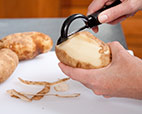 USE RUSSETS
USE RUSSETS
We like the earthy flavor that russets bring to home fries, plus their high starch content helps create a substantial golden-brown crust.
-
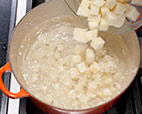 PARBOIL
PARBOIL
Adding potatoes to boiling (not cold) water cooks them more on the outside than on the inside—just the uneven effect we want.
-
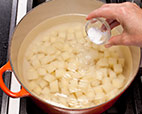 ADD BAKING SODA
ADD BAKING SODA
Baking soda accentuates the uneven cooking by quickly breaking down the exteriors, leaving the insides nearly raw.
-
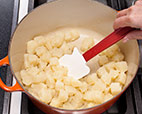 TOSS WITH SALT
TOSS WITH SALT
Salt roughs up the drained potatoes, so their moisture evaporates more readily, leading to better crisping in the oven.
-
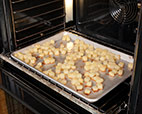 ROAST
ROAST
Pretreated potatoes achieve a “fried” texture after oven roasting. This technique yields three times as many servings as frying in a skillet.
Technique
-
Potato Chain Reaction
While developing a potato salad recipe not too long ago, we discovered that adding vinegar to the cooking water creates an acidic environment that slows the breakdown of the pectin that holds potato cells together, resulting in a firm, intact texture. So when our home fries required a thin outer layer of mush that would brown thoroughly in the oven, we took the opposite approach:
We created an alkaline environment by adding a little bit of baking soda to the water. After just one minute in the pot, the exteriors of the potatoes became so soft that they were mushy—but the interiors remained raw. This lead to potatoes that more readily crisped on the outside when roasted but didn’t dry out on the inside.
How could just 1/2 teaspoon of baking soda added to 10 cups of water be so powerful? It’s because alkaline baking soda triggers a chain reaction that literally unzips the backbone of the pectin molecules and causes them to fall apart. This requires only enough alkali to raise the pH of the water high enough to start the reaction, after which it becomes self-sustaining.
-
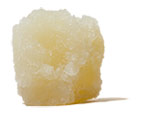 BOILED WITH BAKING SODA (pH 8.1)
BOILED WITH BAKING SODA (pH 8.1)
-
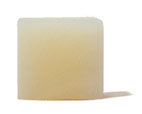 BOILED WITH VINEGAR (pH 3)
BOILED WITH VINEGAR (pH 3)
No comments:
Post a Comment